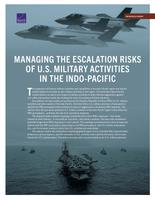管理美国在印太地区军事活动的升级风险
Managing the Escalation Risks of U.S. Military Activities in the Indo-Pacific

【作者】 Bryan Frederick ; Kristen Gunness ; Bonny Lin ; Cortez A. III Cooper ; Bryan Rooney ; James Benkowski ; Nathan Chandler ; Cristina L. Garafola ; Jeffrey W. Hornung ; Karl P. Mueller ; Paul Orner ; Timothy R. Heath ; Christian Curriden ; Emily Ellinger
Research Brief
\ERP-09_Rand-Corp(US)【已采集】\【详情】最新出版 - Published Research(2022-)\1673019572403.jpg)
Photo by Senior Airman Trevor Gordnier/U.S. Air Force
The expansion of Chinese military activities and capabilities in the Indo-Pacific region has led the United States to increase its own military activities in the region. This brief describes how the United States can select and shape its military activities to deter Chinese aggression against U.S. allies and partners while also limiting the risks of escalatory Chinese reactions.
Grounded in 14 case studies of reactions by the People's Republic of China (PRC) to U.S. military activities and other events in the Indo-Pacific, this brief offers U.S. military planners a framework to identify the perceptions that are likely to cause an aggressive or escalatory response. The authors then discuss which potential U.S. military activities in the Indo-Pacific region could affect the perceptions—and thus the risk of an escalatory response.
The research team created a typology of potential short-term responses—from least intense to most intense—in the political, economic, and military spheres. The team also considered potential longer-term responses in each sphere. This typology summarizes the menu of response options that the could select, depending on the perceptions, the U.S. activity characteristics, and the broader context in which the U.S. activities are undertaken.
The authors outline the implications regarding general types of U.S. activities that could escalate tensions to various degrees, specific examples of U.S. activities that could do the same, and broader lessons for U.S. policymakers. This brief concludes with recommendations for U.S. military planners.
\ERP-09_Rand-Corp(US)【已采集】\【详情】最新出版 - Published Research(2022-)\1673019842656.jpg)
Photo by Mass Communication Specialist Seaman Heather McGee/U.S. Navy
The research team based its framework on an extensive analysis of documents, Chinese-language literature, English-language examinations of behavior, and 14 case studies—listed in Figure 1—of recent reactions to U.S. military activities and other events. This analysis, and the framework that arose from it, can help U.S. military planners anticipate China's likely responses to new or expanded U.S. military activities in the Indo-Pacific region.
The framework provides a step-by-step guide for assessing likely responses to U.S. military activities. As noted, the framework consists of three main components:
相关资源